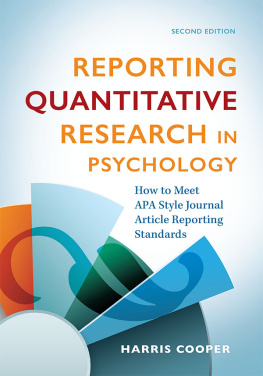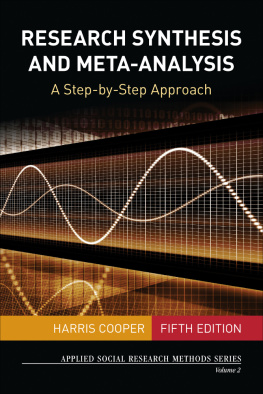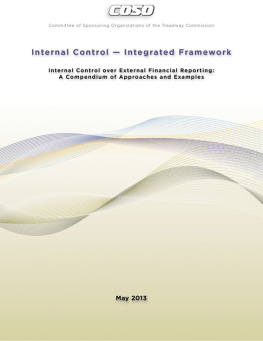Cooper - Reporting quantitative research in psychology how to meet APA style journal article reporting standards
Here you can read online Cooper - Reporting quantitative research in psychology how to meet APA style journal article reporting standards full text of the book (entire story) in english for free. Download pdf and epub, get meaning, cover and reviews about this ebook. year: 2018, publisher: American Psychological Association, genre: Politics. Description of the work, (preface) as well as reviews are available. Best literature library LitArk.com created for fans of good reading and offers a wide selection of genres:
Romance novel
Science fiction
Adventure
Detective
Science
History
Home and family
Prose
Art
Politics
Computer
Non-fiction
Religion
Business
Children
Humor
Choose a favorite category and find really read worthwhile books. Enjoy immersion in the world of imagination, feel the emotions of the characters or learn something new for yourself, make an fascinating discovery.
Reporting quantitative research in psychology how to meet APA style journal article reporting standards: summary, description and annotation
We offer to read an annotation, description, summary or preface (depends on what the author of the book "Reporting quantitative research in psychology how to meet APA style journal article reporting standards" wrote himself). If you haven't found the necessary information about the book — write in the comments, we will try to find it.
Cooper: author's other books
Who wrote Reporting quantitative research in psychology how to meet APA style journal article reporting standards? Find out the surname, the name of the author of the book and a list of all author's works by series.
Reporting quantitative research in psychology how to meet APA style journal article reporting standards — read online for free the complete book (whole text) full work
Below is the text of the book, divided by pages. System saving the place of the last page read, allows you to conveniently read the book "Reporting quantitative research in psychology how to meet APA style journal article reporting standards" online for free, without having to search again every time where you left off. Put a bookmark, and you can go to the page where you finished reading at any time.
Font size:
Interval:
Bookmark:

Ingredients:
cup cold buttermilk
1 tablespoon instant espresso powder
2 teaspoons vanilla extract
1 cup cake flour
6 tablespoons unsweetened cocoa powder
teaspoon salt
teaspoon baking powder
teaspoon baking soda
3 large eggs
cup unsalted butter, room temperature
Instructions:
Preheat oven. Butter three 8-inch diameter cake pans with 1-inch high sides. Line bottom of three pans. Stir buttermilk, espresso powder, and vanilla until powder dissolves. Sift next five ingredients into large bowl. Add eggs and butter; beat until mixture is thick and smooth. Add buttermilk mixture; beat until light and fluffy. Divide batter among pans. Bake about 20 minutes.
Sound tasty? Problem is, I left 1 cup of sugar out of the list of ingredients. What would chocolate cake taste like if the recipe left out sugar? And although I told you to preheat the oven, I forgot to say to what temperature (350 F). If I didnt tell you what temperature to set the oven, what are the chances you could follow my recipe and make the cake? (Oops, those 1-inch high pans should have been 1-inch high; sorry for the mess.)
In many ways, the report of a psychology research project contains a recipe. Without accurate descriptions of the ingredients (the manipulations and measures) and the instructions (research design and implementation), it is impossible for others to replicate what you have done.
Recently, there has been a growing sense in the social and behavioral sciences that the recipes contained in our research reports often do not serve us well. Recognizing this, in 2006 the Publications and Communications Board (P&C Board) of the American Psychological Association (APA) formed a group, the Journal Article Reporting Standards Working Group (JARS Working Group), to look into the issue. The P&C Board wanted to learn about reporting standards that had been developed in fields related to psychology and decide how the issue of reporting standards might be handled in the sixth edition of the Publication Manual of the American Psychological Association (APA, 2010; hereinafter referred to as the Publication Manual).
The P&C Board asked the JARS Working Group to look at existing reporting standards and adapt them for use by psychology researchers and other behavioral scientists, if this was desirable. The first JARS Working Group was composed of five former editors of APA journals..
The JARSQuant Working Group followed the revision process and used the same procedures established by the original JARS Working Group (see ). The report of the JARSQuant Working Group was published in 2018 in American Psychologist (Appelbaum et al., 2018).
Most importantly, JARSQuant now covers types of research that were not included in the original standards. These are included because they often require the reporting of unique features of research that readers need to know in order for the report to be transparent about what was done. Thus, reporting standards for clinical trials, or research that evaluates the effects of a health-related therapeutic intervention, were developed by the JARSQuant Working Group (). These analyses use procedures and the setting of statistical parameters that go beyond those covered in the general JARS table. Finally, some revisions were made to the original JARS tables to make them clearer and add a few new reporting items that have become commonplace in the past decade.
I present many of the various JARS tables in appendices to the chapters in which they are first discussed. These tables can also be found online (http://www.apastyle.org/jars/index.aspx). In addition, I provide boxes in the text that paraphrase the JARS entries when I discuss that particular material. In some instances, JARS recommendations are repeated in different tables. I wont discuss these twice but will address each recommendation when it first appears and refer you back to that discussion when it appears next.
. I briefly describe these here to give you the big picture and then add detail in later chapters.
describes the Method section. This is where the sample, measures, and research design are detailed.
The first design covered involves studies with at least one purposive or experimental manipulation and at least one comparison group that gets a different treatment or is treated in the usual way (whatever that may be). What distinguishes this design is that the experimenter has deliberately varied something about the circumstances that different subjects will experience.
Along with , but not both. The former type of design, involving random assignment, is referred to as an experiment, and the latterthe one not employing random assignmentis called a quasi-experiment.
.
).
in addition to the other tables that are relevant to your design. It is needed if, and only if, you collected data on more than one occasion.
should be used with any combination of the other tables, depending on the design of the earlier study that is being replicated.
relating to reporting your results, you will see that most are relevant to the N-of-1 design, but they would be reported in a decidedly different way.
When studies evaluate a specific type of experimental intervention, namely, the effects of health interventions, they are called clinical trials, and these are also discussed in . Clinical trials can relate to mental health interventions, such as psychotherapy or counseling, or physical health interventions, such as an exercise or dietary program. Clinical trials involve manipulated interventions that are (a) introduced by the experimenters, such as when they recruit subjects to test a new nutrition program, or (b) naturally occurring, such as when a new lunch menu is introduced at a school and researchers are asked to evaluate its effects on student health (e.g., students weight, frequency of absences because of illness).
An additional set of reporting standards is needed for clinical trials because the amount of detail readers must see about this type of study is greater if they are to adequately understand what transpired in the treatment, what the treatment components were, and what the treatment effects might be. A clinical trial may use random or nonrandom assignment ( if your clinical trial was conducted on only one subject.
In , I provide the JARS standards for the Discussion section of every study. I also detail those items that should be discussed depending on which type of group research design or specialized strategy for data analyses you used.
Finally, in is to be used if you conducted a research synthesis or meta-analysis. These recommendations have a different name, the Meta-Analysis Reporting Standards (MARS). This is a distinct type of research that is meant to identify, summarize, and integrate previous research on a topic rather than to collect new data.
The use of different tables for different research designs and analyses makes it possible to expand JARS even further by adding new tables at a later date. As JARS standards are developed, they can be given different table titles (e.g., JARS now has a table titled Reporting Standards for Studies With an Experimental Manipulation; Appelbaum et al., 2018, p. 11) as well as their own subsections within tables (e.g., Module A: Additional Reporting Standards for Studies Using Random Assignment and Module B: Additional Reporting Standard for Studies Using Nonrandom Assignment; Appelbaum et al., 2018, pp. 1112). How they are labeled depends on what is needed to fully capture the variations in that research design.
Font size:
Interval:
Bookmark:
Similar books «Reporting quantitative research in psychology how to meet APA style journal article reporting standards»
Look at similar books to Reporting quantitative research in psychology how to meet APA style journal article reporting standards. We have selected literature similar in name and meaning in the hope of providing readers with more options to find new, interesting, not yet read works.
Discussion, reviews of the book Reporting quantitative research in psychology how to meet APA style journal article reporting standards and just readers' own opinions. Leave your comments, write what you think about the work, its meaning or the main characters. Specify what exactly you liked and what you didn't like, and why you think so.















